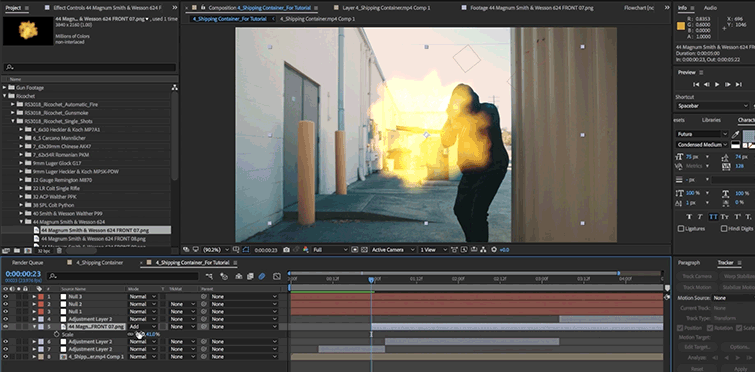
If your effect appears to be almost solid red, it is because Colorama is overwriting the alpha channel. Leave the input as ‘Intensity’ and select ‘Red Ramp’ for the output. In After Effects, you can do this by applying the Colorama effect. To simulate this effect, we add a smoke or dust element on top of the overlay layer. When a bullet hits a person, the impact usually creates a small explosive cloud of blood mist due to the force of the impact. One important thing for the bullet hit is the blood mist cloud. Again, notice that no masking is required. You may have to add a curves adjustment to ensure the lighting is correct and the bullet hole fits into the scene. Scale it and position it right over the centre of the blood. Next, take an image of a bullet hole or a damaged plaster wall and place it over the blood effect layer. Without any extra work the blood appears to be sitting behind our actor :)

Simply take a blood splatter elment and place it above the base footage but under the overlay layer. Now that we have the overlay layer created, we can add some blood splatters for the bullet hit onto the wall behind the actor. Now let’s create the actual bullet hit effect! I usually don’t like to delete it just in case I need to make adjustments and re-export the overlay :) Don’t forget to disable the rotobrush effect on your base footage as we no longer need it. Once we’ve done that, we can reimport the clip into your scene and place it on top of your base footage. To maintain the transparency of the video, I usually export as AVI and set the output channels to RGB+Alpha. The rotobrush tool is not perfect, but it does make your job a lot easier :)īe sure to enable the ‘refine matte’ option on the rotobrush effect, it will make the edges of your overlay look cleaner.īecause the rotobrush effect is really slow to render, we render out our overlay layer. In After Effects CS5 and up, I highly recommend using the rotobrush tool to help you with this task as it can be a little tedious. Starting with the base footage, we first rotoscope out our actor for the duration of the bullet hit to create the overlay layer. Instantly, all bullet hit effects appear to be sitting behind the elements in the overlay layer :DĪnd the best thing about this solution: it’s flexible! I can move or replace all bullet hit elements without any extra work required. I then place all blood/spark/debris effects on top of my base footage layer without masking and then place the overlay layer on top of that. Instead of masking out the elements to sit behind my actors or objects, I rotoscope out the actors or objects and create an overlay layer. To avoid this, I have decided to go another way and it has worked out pretty well so far :) Through the whole frame by frame masking nightmare again :(

Imagine masking them out frame by frame and then you decide to move them or replace them with different footage. One of the most frustrating things about creating visual effects for bullet hits is to ensure all the blood/debris/sparks appear behind your actors or objects in the scene.

#Adobe after effects cs5 muzzle flash tutorial how to
I hope you enjoy this tutorial :) How to Make Realistic Looking Bullet Hit Effects – Visual Effects 101 The Preparation – The Overlay Layer This week I decided to cover the second half of the equation and talk about how to make your bullet hit effects looks awesome :) In last week’s tutorial I talked about how to create convincing looking muzzle flash (gun fire) effects.


 0 kommentar(er)
0 kommentar(er)
